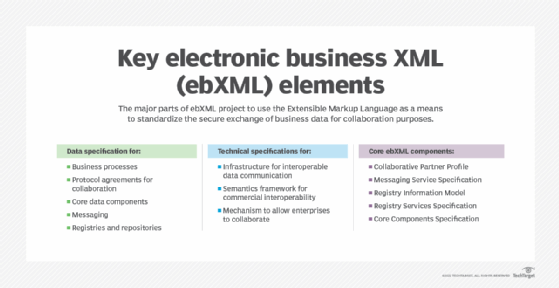ebXML (Electronic Business XML)
What is ebXML (Electronic Business XML)?
EbXML (Electronic Business XML or e-business XML) is a project to use the Extensible Markup Language (XML) to standardize the secure exchange of business data. EbXML was last updated in 2007 and is currently in version 3.0.
Among other purposes, ebXML replaces a familiar standard called Electronic Data Interchange (EDI). However, it is not restrictive. Business messages, or payloads, are not limited to XML document, as they can also be transported by ebXML Messaging Service Specification (ebMS) -- the ebXML protocol for exchanging business messages -- in traditional EDI formats.
What is the background of ebXML?
The United Nations body for Trade Facilitation and Electronic Business Information Standards (UN/CEFACT) and the Organization for the Advancement of Structured Information Standards (OASIS) launched the project as a joint initiative.
Its membership originally included 75 companies, including major IT vendors and trade associations throughout the world.
The initial project has planned to include five layers of data specification for the following:
- business processes
- protocol agreements for collaboration
- core data components
- messaging
- registries and repositories
White papers on the official ebXML website explain that the initiative was built on the following three technical specifications:
- provide an infrastructure that ensures data communication interoperability;
- provide a semantics framework that ensures commercial interoperability; and
- provide a mechanism that allows enterprises to find each other, agree to become trading partners, conduct business processes and exchange business documents with each other.
The ebXML specifications were submitted to the International Organization for Standardization (ISO) TC 154 and approved in 2004. It was there assigned the general title Electronic business eXtensible markup language, and includes the following core components:
- ebXML Collaborative Partner Profile -- ISO 15000-1;
- ebXML Messaging Service Specification -- ISO 15000-2;
- ebXML Registry Information Model -- ISO 15000-3;
- ebXML Registry Services Specification -- ISO 15000-4; and
- ebXML Core Components Specification -- ISO 15000-5.

What is ebXML used for?
EbXML is designed to enable business collaboration through a global electronic marketplace in which enterprises of any size, and in any location, could safely and securely transact business over web services through the exchange of XML-based business messages.
Because ebXML messages rely on the internet's existing standards such as HTTP, TCP/IP, MIME, SMTP, FTP, UML and XML, they can be implemented and deployed on virtually any computing platform. The use of existing standards gives ebXML the advantage of being relatively inexpensive and easy to use.
While ebXML standards offer a formal XML-enabled mechanism, the ebXML architecture can be more broadly applied to enhance the facilitation of other business transactions.
For example, the Core Components Technical Specification and Universal Business Language are both used by OASIS to facilitate XML transactions.








